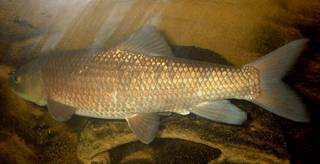
A tuna is a saltwater fish that belongs to the tribe Thunnini, a subgrouping of the Scombridae (mackerel) family. The Thunnini comprise 15 species across five genera, the sizes of which vary greatly, ranging from the bullet tuna up to the Atlantic bluefin tuna, which averages 2 m (6.6 ft) and is believed to live up to 50 years.

Mackerel is a common name applied to a number of different species of pelagic fish, mostly from the family Scombridae. They are found in both temperate and tropical seas, mostly living along the coast or offshore in the oceanic environment.

Herring are forage fish, mostly belonging to the family of Clupeidae.

Tilapia is the common name for nearly a hundred species of cichlid fish from the coelotilapine, coptodonine, heterotilapine, oreochromine, pelmatolapiine, and tilapiine tribes, with the economically most important species placed in the Coptodonini and Oreochromini. Tilapia are mainly freshwater fish inhabiting shallow streams, ponds, rivers, and lakes, and less commonly found living in brackish water. Historically, they have been of major importance in artisanal fishing in Africa, and they are of increasing importance in aquaculture and aquaponics. Tilapia can become a problematic invasive species in new warm-water habitats such as Australia, whether deliberately or accidentally introduced, but generally not in temperate climates due to their inability to survive in cold water.

"Sardine" and "pilchard" are common names for various species of small, oily forage fish in the herring family Clupeidae. The term "sardine" was first used in English during the early 15th century, a folk etymology says it comes from the Italian island of Sardinia, around which sardines were once supposedly abundant.

Trichogaster is a genus of gouramis native to South Asia from Pakistan to Myanmar. It is the only genus in the monotypic subfamily Trichogastrinae as set out in the 5th Edition of Fishes of the World, although that book states that there are two genera, the other being Colisa which is treated as a synonym of Trichogaster by Fishbase and the Catalog of Fishes. Fishbase also places the genus in the Luciocephalinae. Species of this genus are very popular in the aquarium trade.
Percina austroperca, the southern logperch, is a small species of freshwater ray-finned fish, a darter from the subfamily Etheostomatinae, part of the family Percidae, which also contains the perches, ruffes and pikeperches. They are highly resilient with a minimum population doubling time of less than 15 months. It is found in the Escambia and Choctawhatchee river systems in western Florida and southern Alabama.

The thick-lipped gourami is a species of gourami native to Southeast Asia, and is a popular aquarium fish.

The Ripon barbel is an East African ray-finned fish species in the family Cyprinidae. A notably large barb, its maximum recorded total length is 90 cm (35 in).

The Algerian barb or Tunisian barb, is a ray-finned fish species in the family Cyprinidae. It is found in Algeria and Tunisia.
Barbus labiosa is a doubtfully distinct ray-finned fish species in the family Cyprinidae.
Paratherina is a genus of sailfin silversides endemic to the Indonesian island of Sulawesi.

Eels are ray-finned fish belonging to the order Anguilliformes, which consists of eight suborders, 19 families, 111 genera, and about 800 species. Eels undergo considerable development from the early larval stage to the eventual adult stage, and are usually predators.
Stenodus nelma, known alternatively as the nelma, sheefish, siifish, inconnu or connie, is a commercial species of freshwater whitefish in the family Salmonidae. It is widespread in the Arctic rivers from the Kola Peninsula eastward across Siberia to the Anadyr River and also in the North American basins of the Yukon River and Mackenzie River.

An anchovy is a small, common forage fish of the family Engraulidae. Most species are found in marine waters, but several will enter brackish water, and some in South America are restricted to fresh water.

Dolomena labiosa, common name : the thick-lipped conch, is a species of sea snail, a marine gastropod mollusk in the family Strombidae, the true conchs.
Chuanchia labiosa is a species of cyprinid fish that is only found in the upper reaches of the Yellow River basin in the Qinghai–Tibet Plateau of China, where it mostly inhabits slow-flowing cold waters at altitudes above 3,000 m (9,800 ft). It is the only member of its genus, but is related to other schizothoracines like Aspiorhynchus, Diptychus, Gymnodiptychus, Gymnocypris, Oxygymnocypris, Platypharodon, Ptychobarbus, Schizopyge, Schizopygopsis and Schizothorax.
Rasbora labiosa, the slender rasbora, lives in rivers and streams in parts of India. It was first described from the Darna River in the upper Godavari River Basin












